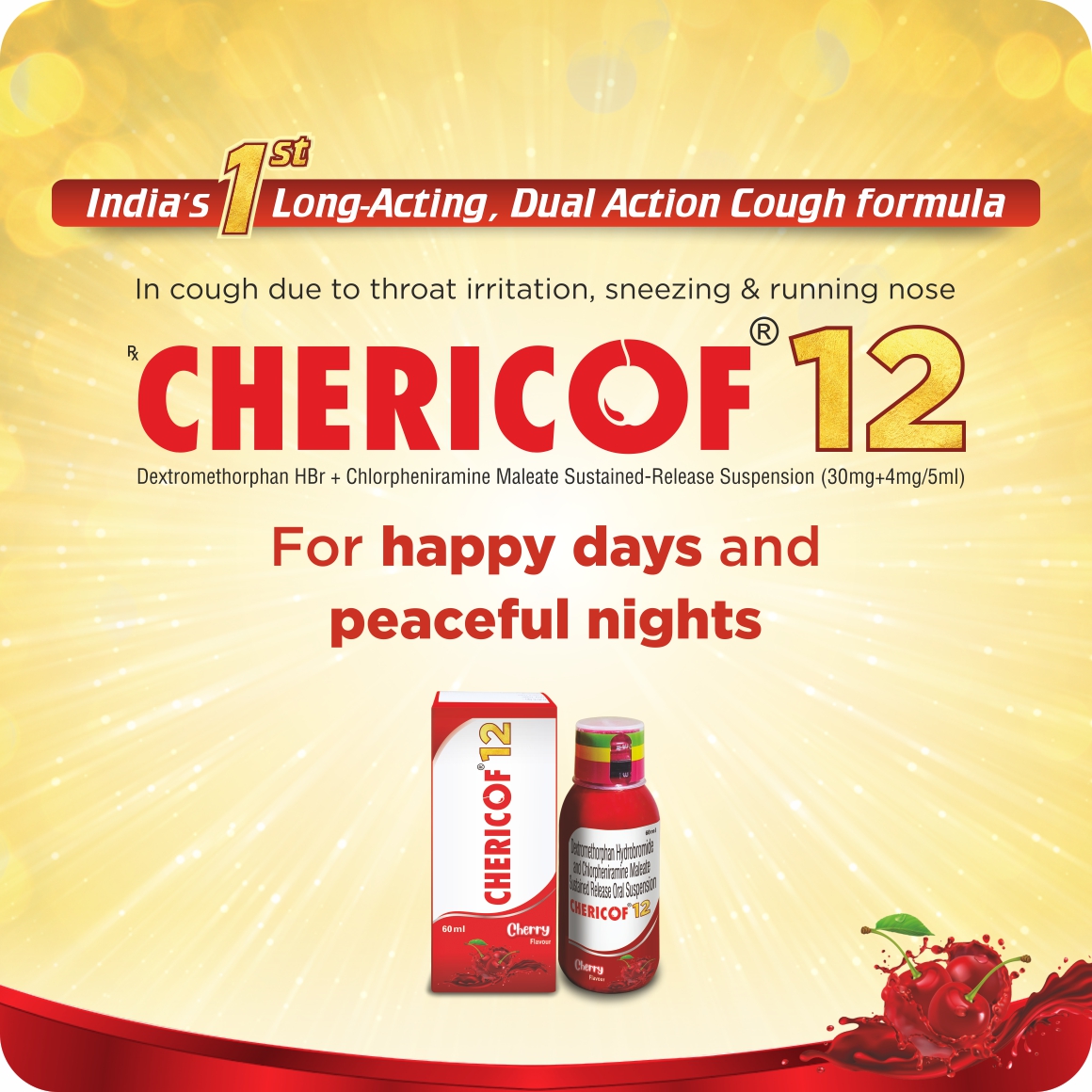Introduction
Composition
Chericof 12 (Dextromethorphan Polistirex equivalent to Dextromethorphan Hydrobromide IP 30 mg, Chlorpheniramine Polistirex equivalent to Chlorpheniramine Maleate IP 4 mg, In a flavoured syrupy base q.s.)
Uses
Chricof-12 is indicated for the temporary relief of cough, due to throat irritation, sneezing and running nose
Pack:

Technology
CHERICOF 12 is manufactured using Polistirex technology for sustained release drug delivery. It is a 3-step process of Drug-resin complexation of Dextromethorphan & Chlorpheniramine maleate. Dextromethorphan is complexed with Resin to form Dextromethorphan-Resin complex and then impregnated with PEG & further coated with ethylocellulose. Chlorpheniramine is complexed with resin to form Chlorpheniramine-Resin complex. Both these drug-resin complexes are then mixed in suspension base to form Chericof 12. In-vitro study demonstrates that due to the Polistirex technology, the release of Dextromethorphan and Chlorpheniramine maleate happen up to 12 hours in gradual manner respectively, thus reducing the dosing frequency from 4-times a day to only 2-times a day. Bioequivalence study shows that Chericof 12 is bioequivalent with Delsym® ER for Dextromethorphan component and with Piriton® for Chlorpheniramine component.
Mechanism of Action
Dextromethorphan Hydrobromide: Dextromethorphan Hydrobromide is a cough suppressant which has a central action on the cough centre in the medulla. It has no analgesic properties and little sedative activity. The mechanism of DXMs cough suppressant proprieties is not completely clarified but it is thought to result from depressing the medullary cough center through sigma 1 receptor stimulation and NMDA receptors antagonism, thus decreasing the cough reflex sensitivity and elevating the threshold for cough initiation. DXM stimulates sigma1 receptor and blocks NMDA receptors, mechanism that may be underlying its cough suppressant properties, and may also be the basis for its anticonvulsant and neuroprotective effects. Additionally, sigma 1 receptor activation is associated with antidepressant-like activity and, when high doses of DXM are present, may induce a schizophrenic-like mental state; these elevated DXM doses act on NMDA receptors, and can induce euphoria and hallucinogenic and dissociative effects. Some of these effects are also carried by DXM’s metabolites, and DXO, its main active metabolite, may be the major responsible compound for the psychotic and dissociative. Serotonin enhancement contributes to its abuse potential and to the risk of serotonin syndrome that can increase with certain drug interactions.
Chlorpheniramine Maleate Antihistamines diminish or abolish the actions of histamine in the body by competative reversible blockade of histamine H1 -receptor sites on tissues. Chlorpheniramine also has anticholinergic activity. Antihistamines act to prevent the release of histamine, prostaglandins and leukotrines and have been shown to prevent the migration of inflammatory mediators. The actions of chlorpheniramine include inhibition of histamine on smooth muscle, capillary permeability and hence reduction of oedma and wheal in hypersneitivity reactions such as allergy and anaphylaxis.
Dosing & Storage
Dosage instructions
Sustained release oral suspension; (30 mg + 4 mg) / 5 ml.
Chericof-12 is for oral administration only. Shake well before each use. Do not exceed the stated dose or frequency of dosing.
Adults and children 12 years of age and older: The recommended dose of Brand Name is 10 ml every 12 hours.
Children (6 to under 12 years of age): The recommended dose of Brand Name is 5 ml every 12 hours.
Chericof-12 is not recommended in children under 6 years.
Storage instructions
Keep the bottle cap tightly closed.
Store at temperature not exceeding 25o C, protecte margin: auto; display: block;d from light and moisture.
Additional Information
Contraindications
Hypersensitivity to antihistamines or any of the ingredients in this formulation.
Taking a monoamine oxidase inhibitor (MAOI), a selective serotonin reuptake inhibitor (SSRI), or other medications for depression, psychiatric, or emotional conditions, or Parkinson's disease, or for 2 weeks after stopping the medication.
Effect of medicine on the liver, kidney, pregnant women, or nursing mother
Pregnant women:
- Dextromethorphan Hydrobromide: Although dextromethorphan has been in widespread use for many years without apparent ill-consequence, there are no specific data on its use during pregnancy. Caution should therefore be exercised by balancing the potential benefit of treatment against any possible hazards.
- Chlorpheniramine Maleate: There are no adequate data from the use of chlorpheniramine in pregnant women. The potential risk for humans is unknown, use during the third trimester may result in reactions in the new-born or premature neonates. Not to be used during pregnancy unless considered essential by a physician.
Lactating women:
- Dextromethorphan Hydrobromide: It is not known whether dextromethorphan or its metabolites are excreted in human milk.
- Chlorpheniramine Maleate: Chlorpheniramine Maleate and other antihistamines may inhibit lactation and may be secreted in breast milk. Not to be used during lactation unless considered essential by a physician.
- Paediatric patients: Chericof -12 is not recommended in children under 6 years.
- Hepatic impairment: Caution should be exercised while using in patients with severe hepatic impairment.
- Renal impairment: Caution should be exercised while using in patients with severe renal impairment.
